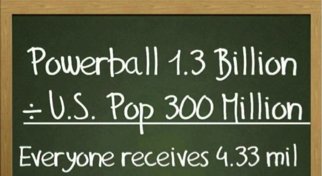Powerball fever took over the U.S. in recent weeks, and it culminated in an aspirational post last week when someone suggested that if the winner split the $1.3 billion equally amongst 300 million Americans, it would give each person $4.3 million. While the post went viral, the reasons why were surprising to many folks.

Let’s take a look at the quick math… 1.3 billion divided by 300 million. That’s a lot of zeros, but it doesn’t take advanced math to write out the computation:
1,300,000,000 / 300,000,000 = 4.33
4.33 DOLLARS, not 4,300,000… Or 4.33 million
If you’re still reading, chances are you’re not one of America’s newest millionaires, so let’s take a look at how the GMAT can trip you up by asking you to convert units.
Let’s think about some common conversions you already know.
12 inches = 1 foot
3 feet = 1 yard
60 seconds = 1 minute
Now, let’s complicate this by asking you to multiply or divide multiple units such as converting feet traveled per second to kilometers per hour. For example, if a car travels 12 feet per second, how many kilometers per hour is that?
If we know that there are 5280 feet in a mile and 1.60934 km in a mile, let’s tackle one unit at a time.
(12 feet / second) x (3600 seconds / hour) x (1 mile / 5280 feet) x (1.60934 km/1 mile) = 13.167 km/hr
Set up your units so that they cancel each other out. So you multiple 12 x 3600 x 1.60934 and then divide by 5280.
When you’re done, think about the answer. Does it make sense? 12 feet / second is equal to 720 (12 x 60) feet per minute or 8.18 miles per hour. Kilometers are shorter than miles, so it makes sense that our answer is larger than 8.
You might be thinking that conversion was pretty easy – a few steps, but fairly straight forward. Let’s take a look at a more complicated way this might be tested.
The distance from Shane’s house to his university is 27 x 106 inches, and Shane’s car gets 23 miles to the gallon on average. If he has 20 gallons in his gas tank, does he need to stop for gas on the way back to school? (1 mile = 63360 inches)
We can write out 27 x 106 as 27,000,000 and set up our first conversion:
27,000,000 inches / 63360 (inches / mile) = 426.14 miles
If Shane gets 23 miles to gallon and has 20 gallons of gas, he can travel 460 miles. Therefore, he doesn’t need to stop for gas.
A question like this might be modified as a data sufficiency problem with a similar question and the given data split as Statements 1 and 2. Or perhaps a problem solving question might ask you to do a more complicated conversion with much larger numbers.
It’s definitely worthwhile to spend some time reviewing your unit conversion skills. It’ll help you on the GMAT, and it’ll probably help you avoid going down in social media infamy for a math blunder.
The above GMAT Tip comes from Veritas Prep. Since its founding in 2002, Veritas Prep has helped more than 100,000 students prepare for the GMAT and offers the most highly rated GMAT Prep course in the industry.
Special Offer: enroll in a Veritas GMAT prep course via the Clear Admit website and save $100!
Join Veritas Prep’s Director of Admissions Consulting, Travis Morgan, for a Free MBA Admissions Workshop. This MBA Admissions Workshop will teach you how to highlight your application strengths and mitigate your application weaknesses.





